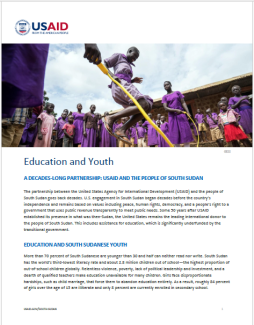EDUCATION AND SOUTH SUDANESE YOUTH
More than 70 percent of South Sudanese are younger than 30 and half can neither read nor write. South Sudan has the world’s third-lowest literacy rate and about 2.8 million children out of school—the highest proportion of out-of-school children globally. Relentless violence, poverty, lack of political leadership and investment, and a dearth of qualified teachers make education unavailable for many children. Girls face disproportionate hardships, such as child marriage, that force them to abandon education entirely. As a result, roughly 84 percent of girls over the age of 15 are illiterate and only 8 percent are currently enrolled in secondary school.
Additionally, a lack of formal teacher training, unclear career tracks, inconsistent salary payments, and low pay force teachers to leave teaching to find better paying jobs. USAID increases access to quality education for all students with a particular focus on girls’ education. Since 2002, USAID has helped millions of South Sudanese learn foundational literacy and numeracy skills, gain employment, make safe sexual and reproductive health choices, and promote peace.
INCREASING ACCESS TO QUALITY EDUCATION
During the 2013 civil war, armed groups recruited more than 19,000 children into their militias, wiping out the future hopes of many of South Sudan’s youngest citizens and perpetuating cycles of violence. Since independence, two civil conflicts, widespread subnational violence and insecurity, record flooding, catastrophic humanitarian crises, and deepening levels of poverty have forced many children to drop-out of school or forego an education. For others, long distances between home and school, poor infrastructure, and a lack of qualified teachers have degraded already-limited education opportunities.
Working with other donors, USAID increases access to equitable and quality education for all students, including girls and those with disabilities. To date, we have reached over one million girls in grades five through 12 with cash stipends that offset the costs of education, mentored schoolgirls to keep them in school, and conducted community dialogues to shift social norms around educating girls and children with disabilities. We have reached thousands of youth with resources and skills, including basic literacy and numeracy skills, so they can lead peaceful and productive lives. And we are helping 135,000 children who live in crisis and conflict areas gain access to education.
EQUIPPING SOUTH SUDAN'S YOUNG MAJORITY WITH ESSENTIAL LIFE SKILLS
The majority of South Sudan’s population are youth between 15 and 29 who do not have the education or skills they need to lead healthy, peaceful, and productive lives. With few opportunities to earn an education or find employment, young people often fall prey to criminal activity, join armed groups, are the victims of early marriage, and miss critical opportunities to shape the future of their communities and country.
USAID’s focus on youth spans our development portfolio. From helping youth learn to read and perform basic calculations, to increasing their skills and helping them gain job experience, USAID works with thousands of young women and men so that they can participate constructively in South Sudanese society, build peaceful relationships across communities, and lay the foundation for a more prosperous future. USAID provides 25,000 youth with literacy skills, 7,850 with work experience, and 100,000 with sexual and reproductive health information—critical information often neglected in South Sudan to the detriment of the health and well-being of many South Sudanese. We promote and amplify youths’ voices through radio talk shows and community dialogues; we fund sports teams and events to reinforce the value of teamwork and camaraderie; and we support activities that promote peaceful debate and sharing of ideas.


